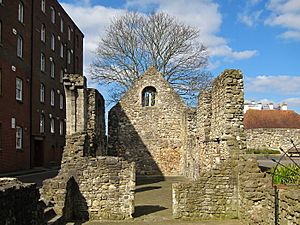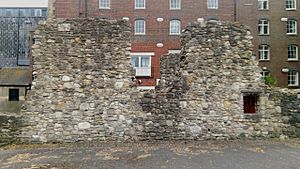Canute's Palace facts for kids
Quick facts for kids Canute's Palace |
|
|---|---|
 |
|
| Location | Porters Lane, Southampton City Centre |
| OS grid reference | SU4194811002 |
| Elevation | 5 metres (16 ft) |
| Built | Between 1170 and 1200 |
| Reference no. | 1001935 |
|
Listed Building – Grade I
|
|
| Designated | 14 July 1953 |
| Reference no. | 1340013 |
| Lua error in Module:Location_map at line 420: attempt to index field 'wikibase' (a nil value). | |
Canute's Palace in Southampton, England, is a cool old building. It's actually the ruins (what's left) of a merchant's house from the Norman era (around the late 1100s). Even though it's called "Canute's Palace," it wasn't really a palace. It also has no connection to Canute the Great, a famous Viking king.
Why is it Called Canute's Palace?
The name "Canute's Palace" is a bit misleading! An expert on old buildings, Sir Henry Englefield, thought it might have been King Canute's palace. In 1801, he wrote a paper about the building.
He wondered if it was the place where Canute taught his courtiers a lesson. The story goes that Canute showed them he couldn't stop the tide, even though they flattered him. Sir Englefield thought this house might have been where Canute watched the tide.
Later, in 1833, a writer in The Gentleman's Magazine also mentioned the building. They called it a "magnificent Norman mansion" but said it was "improperly called Canute's Palace." So, people knew even back then that the name wasn't quite right!
What Does Canute's Palace Look Like?
This building was once known as the 'Long House'. It was built between 1170 and 1200. Its walls are made of rough stones. Back then, it faced the waterfront before the city walls were built.
The house had two floors. It was built in a style called a hall house. The room on the upper floor, at the eastern end, might have been the merchant's office. Here, they would have kept their accounts and managed their business.
You can still see a window with two round tops. This window wasn't part of the original design but was added later during the Norman period. The wall at the western end is still very tall, but most of it has been rebuilt over time. This tall wall also has another round-headed window.
Canute's Palace is now a scheduled monument. This means it's an important historical site protected by law. It's also a Grade I listed building, which is the highest level of protection for historic buildings in England. It got this status on July 14, 1953. Today, the ruins are part of Town Quay Park. This park includes parts of many other old buildings in the southern area of Southampton.


